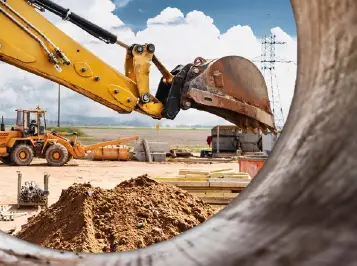In the construction industry, hydraulic systems, including directional valves, proportional valves, pressure switches, and flow control valves, are vital for operating heavy machinery efficiently and safely. Here’s how each component is used:
Hydraulic Directional Valves:
- Excavators and Backhoes: These valves control the movement of the boom, arm, and bucket by directing fluid to specific hydraulic cylinders or motors. This ensures precise digging, lifting, and dumping operations.
- Cranes and Hoists: Directional valves enable the extension and retraction of booms and the rotation of crane structures, crucial for lifting heavy loads.
- Loaders: They regulate the hydraulic flow to arms and buckets, enabling smooth and controlled material handling.
- Graders and Pavers: These valves control blade or screed movement for leveling and paving tasks.
Hydraulic Proportional Valves:
- Smooth and Precise Control: Proportional valves provide variable adjustments of flow and pressure based on electronic signals, ensuring smooth and precise movement of machinery like excavators and graders.
- Multi-functionality: They allow operators to perform multiple tasks simultaneously, such as lifting and rotating a load, which is critical for efficient operations in cranes and multi-purpose machinery.
- Energy Efficiency: Proportional valves regulate hydraulic systems to use only the necessary flow and pressure, reducing energy consumption and wear.
Pressure Switches:
- Safety Mechanisms: Pressure switches monitor the hydraulic pressure in systems and can activate alarms or shut down equipment when pressure exceeds safe limits.
- System Feedback: They provide real-time pressure data to operators or control systems, ensuring machinery operates within optimal parameters.
- Automatic Operations: In machinery like pile drivers or compactors, pressure switches can trigger actions (e.g., stopping or reversing a cycle) once a set pressure is reached.
Flow Control Valves:
- Speed Regulation: These valves control the speed of hydraulic actuators, such as cylinders and motors, by adjusting the flow rate. For example, they ensure precise bucket movement in excavators or controlled blade adjustments in graders.
- Efficient Resource Usage: Flow control valves optimize the hydraulic system’s efficiency by managing the distribution of fluid across various functions.
- Adaptability: They enable fine-tuning of equipment performance to match specific job requirements, such as varying the speed of conveyor belts or adjusting the lifting speed of cranes.
Combined Use in Construction Machinery:
- Earthmoving Equipment: All these components work together to manage hydraulic systems in excavators, bulldozers, and loaders, ensuring power, precision, and efficiency.
- Road Construction Machines: Graders, asphalt pavers, and compactors rely on precise hydraulic controls to achieve smooth and even surfaces.
- Drilling and Pile Driving Rigs: Proportional valves and pressure switches are crucial for controlling the force and depth of drilling or pile driving.
- Concrete Equipment: Directional and flow control valves regulate the operation of concrete pumps and mixers, ensuring consistent flow and mixing quality.
These hydraulic components ensure construction machinery is reliable, efficient, and capable of handling demanding tasks with precision and safety

